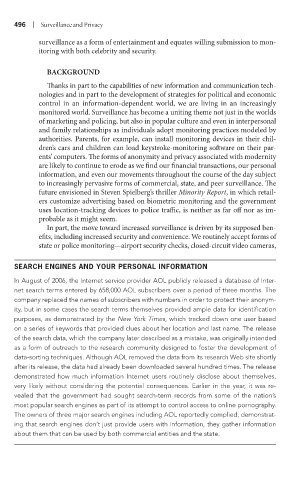Page 517 - Battleground The Media Volume 1 and 2
P. 517
| Surve llance and Pr vacy
surveillance as a form of entertainment and equates willing submission to mon-
itoring with both celebrity and security.
BaCkgrounD
Thanks in part to the capabilities of new information and communication tech-
nologies and in part to the development of strategies for political and economic
control in an information-dependent world, we are living in an increasingly
monitored world. Surveillance has become a uniting theme not just in the worlds
of marketing and policing, but also in popular culture and even in interpersonal
and family relationships as individuals adopt monitoring practices modeled by
authorities. Parents, for example, can install monitoring devices in their chil-
dren’s cars and children can load keystroke-monitoring software on their par-
ents’ computers. The forms of anonymity and privacy associated with modernity
are likely to continue to erode as we find our financial transactions, our personal
information, and even our movements throughout the course of the day subject
to increasingly pervasive forms of commercial, state, and peer surveillance. The
future envisioned in Steven Spielberg’s thriller Minority Report, in which retail-
ers customize advertising based on biometric monitoring and the government
uses location-tracking devices to police traffic, is neither as far off nor as im-
probable as it might seem.
In part, the move toward increased surveillance is driven by its supposed ben-
efits, including increased security and convenience. We routinely accept forms of
state or police monitoring—airport security checks, closed-circuit video cameras,
searCh engines and your Personal inForMation
In August of 2006, the Internet service provider AOL publicly released a database of Inter-
net search terms entered by 658,000 AOL subscribers over a period of three months. The
company replaced the names of subscribers with numbers in order to protect their anonym-
ity, but in some cases the search terms themselves provided ample data for identification
purposes, as demonstrated by the New York Times, which tracked down one user based
on a series of keywords that provided clues about her location and last name. The release
of the search data, which the company later described as a mistake, was originally intended
as a form of outreach to the research community designed to foster the development of
data-sorting techniques. Although AOL removed the data from its research Web site shortly
after its release, the data had already been downloaded several hundred times. The release
demonstrated how much information Internet users routinely disclose about themselves,
very likely without considering the potential consequences. Earlier in the year, it was re-
vealed that the government had sought search-term records from some of the nation’s
most popular search engines as part of its attempt to control access to online pornography.
The owners of three major search engines including AOL reportedly complied, demonstrat-
ing that search engines don’t just provide users with information, they gather information
about them that can be used by both commercial entities and the state.

